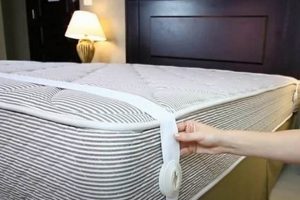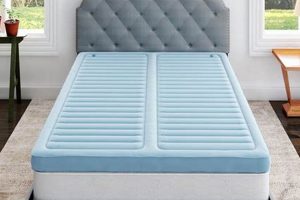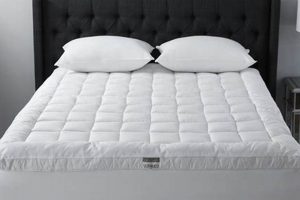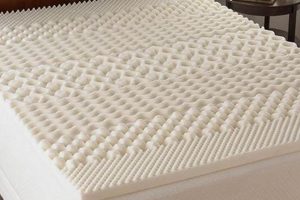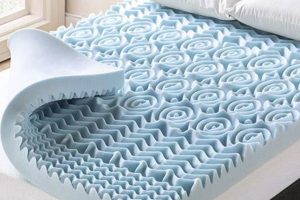A layer placed atop a mattress, its role involves modifying the sleeping surface’s characteristics. This addition primarily aims to enhance comfort, provide support, or protect the underlying mattress. As an example, individuals seeking a softer sleeping surface may choose a memory foam addition, while others needing firmer support might opt for a latex variety.
The significance of this layer lies in its ability to extend the lifespan of a mattress by shielding it from wear and tear, spills, and stains. Furthermore, it offers a more economical alternative to replacing an entire mattress when seeking improved sleep quality or addressing specific comfort needs. Historically, simpler forms have existed for centuries, evolving from basic padding to the technologically advanced materials available today.
The subsequent sections will delve into the specific types available, factors to consider when selecting one, and the potential improvements this addition can bring to sleep quality and overall well-being. This exploration will provide a comprehensive understanding of how this bedding accessory can contribute to a more restful and comfortable sleep experience.
Selection and Utilization Guidance
The following provides practical advice to maximize the benefits derived from a mattress addition.
Tip 1: Evaluate Existing Mattress Condition: Assess the state of the current mattress. A severely damaged or sagging mattress will not be adequately improved by simply adding a layer; replacement may be necessary.
Tip 2: Identify Primary Need: Determine the core requirement. Is it increased softness, firmer support, temperature regulation, or protection from allergens? This will guide the choice of material and thickness.
Tip 3: Research Material Options: Explore the properties of various materials, including memory foam, latex, wool, and down alternatives. Each offers distinct advantages regarding comfort, support, and breathability.
Tip 4: Consider Thickness and Density: Analyze the thickness and density of the selected material. Thicker, denser options typically provide more significant alterations to the mattress feel, suitable for pronounced comfort adjustments.
Tip 5: Review Warranty and Return Policies: Examine the warranty and return policies of the manufacturer and retailer. This allows for testing the product and returning it if it does not meet expectations or provide the desired comfort level.
Tip 6: Ensure Proper Fit: Verify that the addition fits the mattress dimensions correctly. An ill-fitting layer can bunch up, shift, or fail to provide uniform support across the sleeping surface.
Tip 7: Maintain Cleanliness: Regularly clean the mattress addition according to the manufacturer’s instructions. This prevents the buildup of dust mites, allergens, and odors, preserving its hygiene and lifespan.
Proper assessment and implementation of these tips can substantially improve sleep quality and mattress longevity.
Subsequent discussions will address specialized considerations for individuals with specific health conditions or sleep preferences.
1. Comfort Enhancement
Comfort enhancement is a primary determinant in the selection and utilization of a mattress layer. Its influence on sleep quality and overall well-being warrants detailed examination. The objective is to align the sleeping surface with individual comfort preferences, ultimately improving restfulness.
- Pressure Point Alleviation
Alleviating pressure points is crucial for uninterrupted sleep. A conforming material, such as memory foam, redistributes body weight, reducing stress on areas like hips, shoulders, and knees. This is particularly relevant for side sleepers who experience concentrated pressure on these joints. By minimizing discomfort, individuals can achieve deeper and more restorative sleep.
- Surface Softening or Firming
The capacity to alter the firmness of a sleep surface represents a significant advantage. A softer layer can provide a plush feel for individuals who find their current mattress too rigid, while a firmer option can offer additional support for those seeking improved spinal alignment. This adaptability is especially beneficial for individuals with back pain or other orthopedic concerns.
- Motion Isolation
Motion isolation minimizes the transfer of movement across the mattress surface. This is particularly important for couples, as it prevents one partner’s movements from disturbing the other’s sleep. Materials like memory foam excel at absorbing motion, providing a more stable and undisturbed sleep environment.
- Temperature Regulation for Comfort
Regulating temperature is vital for maintaining a comfortable sleep climate. Certain materials, like wool or breathable latex, promote airflow and dissipate heat, preventing overheating during sleep. This is especially important for individuals who tend to sleep hot or who live in warmer climates. A comfortable temperature contributes to improved sleep quality and reduces the likelihood of nighttime awakenings.
These facets collectively illustrate how the selection and integration of a suitable addition to a mattress can significantly enhance comfort. Addressing individual preferences and needs in these areas contributes to a more restful and restorative sleep experience, ultimately fulfilling a key objective of a well-chosen sleep setup.
2. Support modification
The inherent purpose of a mattress overlay frequently extends beyond simple comfort augmentation to encompass the critical function of support modification. This facet addresses the specific orthopedic requirements of the sleeper, influencing spinal alignment and pressure distribution. A direct correlation exists: the degree to which a mattress addition can effectively alter support directly impacts its overall utility. In instances where an individual experiences lower back pain due to inadequate lumbar support from their existing mattress, a firmer latex or high-density foam layer can provide targeted reinforcement, mitigating discomfort. This addresses a deficiency in the original mattress, adapting it to meet specific needs.
Furthermore, the strategic adjustment of support can rectify imbalances introduced by mattress degradation. Over time, mattresses may develop indentations or sagging, leading to uneven support and compromised sleep posture. A properly selected addition, such as a zoned support layer, can redistribute weight and counteract these effects, providing a more level and supportive sleeping surface. For example, athletes or individuals with physically demanding professions may find a support-enhancing option beneficial for muscle recovery and joint stabilization during sleep
.
In summary, the ability to modify support constitutes a central element of the addition’s overall utility. It addresses critical orthopedic needs, adapts to the changing condition of the mattress, and promotes proper spinal alignment. Understanding this function is essential for selecting an appropriate product and maximizing its benefits for sleep quality and physical well-being.
3. Mattress protection
The function of mattress protection directly correlates with the comprehensive role served by a mattress addition. Preservation of the underlying mattress from various degrading factors constitutes a fundamental element of its design and usage. Spills, stains, body oils, and allergens can permeate a mattress over time, compromising its hygiene and lifespan. A mattress addition acts as a barrier, mitigating direct exposure and minimizing the accumulation of these contaminants. This protective measure subsequently contributes to maintaining the mattress’s structural integrity and prolonging its usable life. As an example, a waterproof mattress addition safeguards against accidental liquid spills, preventing absorption into the core mattress layers and precluding the growth of mold or mildew.
Furthermore, the protective layer safeguards against physical wear and tear. Constant pressure and friction from body weight can cause compression and degradation of the mattress materials over time. The strategic placement of a durable mattress addition reduces the direct impact of these forces on the underlying mattress, distributing weight and minimizing localized stress points. This is particularly important for mattresses constructed from softer materials that are more susceptible to compression. In a practical application, a mattress addition can be used to shield a new mattress during a relocation process, preventing damage from bumps, scratches, or stains.
In summary, the protective aspect of a mattress addition is an essential facet of its overall function. By shielding the mattress from various forms of physical and environmental degradation, it promotes mattress longevity, maintains hygiene, and safeguards against irreversible damage. Understanding this fundamental connection between mattress protection and the intended purpose of the item is crucial for making informed decisions regarding selection and utilization, ultimately maximizing the value and lifespan of the investment.
4. Longevity extension
The extension of a mattress’s lifespan is a significant benefit derived from the strategic implementation of a mattress addition, directly fulfilling its intended role. The initial investment in a mattress represents a considerable expense. Therefore, maintaining its structural integrity and prolonging its usability are paramount considerations. A mattress addition serves as a protective barrier, mitigating wear and tear that would otherwise accelerate the degradation of the underlying mattress core. This preventative measure directly translates to a deferred need for replacement, yielding long-term cost savings. Consider a scenario where a family with young children uses a waterproof mattress addition. This effectively shields the mattress from spills and accidents, preventing irreversible staining or damage that would necessitate premature replacement.
The mechanism by which a mattress addition extends longevity encompasses several key aspects. As a sacrificial layer, it absorbs much of the daily wear, including compression, friction, and the accumulation of body oils and dead skin cells. Without this protection, these elements would directly impact the mattress, leading to premature sagging, reduced support, and compromised hygiene. Furthermore, the addition can prevent the formation of indentations or body impressions that commonly occur over time, particularly in memory foam mattresses. This maintenance of the mattress’s original form preserves its structural integrity and postpones the need for a replacement. For example, the utilization of a high-density latex addition can provide enhanced support and resistance to compression, effectively extending the life of a lower-quality innerspring mattress.
In conclusion, longevity extension is an integral component of a mattress addition’s function. By acting as a protective barrier, absorbing daily wear, and maintaining structural integrity, it directly contributes to the preservation and prolonged usability of the underlying mattress. While the initial investment in a quality addition may seem substantial, the long-term savings accrued by delaying mattress replacement represent a tangible return on investment. This understanding underscores the practical significance of considering longevity extension when evaluating the purpose and benefits of a mattress addition.
5. Pressure relief
Pressure relief represents a critical function of a mattress addition, directly impacting sleep quality and physical well-being. Its relevance stems from the reduction of concentrated force on specific areas of the body during sleep, promoting improved circulation and minimizing discomfort. The subsequent details delineate specific aspects of this function.
- Weight Distribution
The primary mechanism for pressure relief involves the redistribution of body weight across a wider surface area. By conforming to the body’s contours, materials like memory foam or latex minimize the concentration of pressure on bony prominences such as hips, shoulders, and knees. For instance, a side sleeper often experiences significant pressure on the shoulder and hip; a conforming layer mitigates this by distributing the weight more evenly. This even distribution reduces stress on these areas, leading to improved comfort and reduced pain.
- Spinal Alignment
Proper spinal alignment is intrinsically linked to effective pressure relief. When a mattress addition conforms to the body, it supports the natural curvature of the spine, preventing undue stress on spinal joints and muscles. For example, a mattress addition with zoned support can provide targeted reinforcement in the lumbar region, maintaining proper spinal alignment for back sleepers. This alignment alleviates pressure on the spine, reducing back pain and promoting more restful sleep.
- Circulation Improvement
Sustained pressure on certain areas of the body can impede blood circulation, leading to discomfort and restlessness. A pressure-relieving layer minimizes this localized compression, allowing for improved blood flow throughout the night. For instance, individuals with circulatory issues or those who spend long periods lying down may benefit significantly from a mattress addition that promotes healthy circulation, reducing the likelihood of numbness, tingling, or discomfort.
- Joint Pain Reduction
Pressure relief directly contributes to the reduction of joint pain by minimizing the stress on articulation points. Individuals with arthritis or other joint conditions often experience heightened discomfort due to pressure on inflamed joints. A conforming mattress addition can cushion these areas, reducing pressure and alleviating pain. For example, a gel-infused memory foam addition can provid
e both cushioning and cooling properties, further enhancing comfort for individuals with joint pain.
The facets detailed above demonstrate the integral role of pressure relief in the overall benefits associated with mattress additions. By addressing key aspects such as weight distribution, spinal alignment, circulation, and joint pain, these additions offer a practical and effective means of enhancing sleep quality and promoting physical well-being.
6. Temperature regulation
The maintenance of a stable sleep temperature is intrinsically linked to the intended function of a mattress addition. The human body experiences fluctuations in temperature during sleep, and disruptions to this thermal equilibrium can negatively impact sleep quality. A mattress addition engineered for temperature regulation addresses this by either dissipating excess heat or providing insulation, thereby creating a more conducive sleep environment. The choice of materials significantly influences this aspect; for example, open-cell memory foam or natural latex allows for greater airflow compared to traditional memory foam, mitigating heat retention. Conversely, wool acts as a natural insulator, maintaining warmth in cooler environments. The direct effect of temperature regulation on sleep is evident in instances where individuals who typically experience night sweats find relief through the use of a breathable mattress addition.
The practical application of temperature-regulating features extends beyond mere comfort. Individuals with certain medical conditions, such as menopause or hyperhidrosis, may find a significant reduction in sleep disturbances through the utilization of specialized mattress additions. Furthermore, the selection of appropriate bedding, including sheets and blankets, in conjunction with a temperature-regulating mattress addition, creates a synergistic effect, optimizing the sleep climate. For example, pairing a wool mattress addition with breathable cotton sheets can promote both warmth and airflow, accommodating a wide range of individual preferences and environmental conditions.
In summary, temperature regulation is a crucial component of a mattress addition’s functionality, influencing sleep quality and overall well-being. Challenges remain in developing materials that effectively regulate temperature across diverse climatic conditions and individual physiological variations. However, understanding the relationship between material properties, sleep temperature, and individual needs is essential for maximizing the benefits derived from a mattress addition, ensuring a more restful and restorative sleep experience.
Frequently Asked Questions about Mattress Additions
The subsequent section addresses common inquiries and misconceptions regarding the purpose and effective utilization of these bedding accessories. The intent is to provide clear and concise answers grounded in current knowledge and best practices.
Question 1: Is a mattress addition a substitute for a new mattress?
A mattress addition can enhance the comfort and support of an existing mattress, but it is not a replacement for a mattress that is significantly damaged or worn out. An addition is most effective when used on a mattress that is in relatively good condition but requires modification to meet specific comfort needs. A severely sagging or damaged mattress will not be adequately improved by an addition alone.
Question 2: What is the typical lifespan of a mattress addition?
The lifespan varies depending on the materials used and the level of usage. High-density foam or latex additions generally last longer than fiberfill or low-density foam options. Regular cleaning and proper maintenance can also extend the lifespan. A range of three to eight years is typical, with higher-quality additions often exceeding this range.
Question 3: Can a mattress addition correct poor spinal alignment?
A mattress addition can improve spinal alignment by providing enhanced support or contouring to the body’s natural curves. However, severe spinal misalignments may require medical intervention. The selection of an appropriate addition with the correct firmness and support characteristics is crucial for achieving optimal spinal alignment.
Question 4: Are all mattress additions hypoallergenic?
Not all mattress additions possess hypoallergenic properties. Natural latex and certain synthetic materials are inherently hypoallergenic, while others may require specific treatments to reduce allergen accumulation. Reviewing product specifications and certifications is essential for individuals with allergies or sensitivities.
Question 5: Does a mattress addition trap heat?
Some materials, such as traditional memory foam, can retain heat. However, advancements in materials and construction have led to the development of additions with improved breathability. Open-cell foam, gel infusions, and natural fibers like wool promote airflow and reduce heat buildup. Material selection should consider individual temperature preferences.
Question 6: How does the thickness of a mattress addition affect its performance?
Thickness significantly impacts the degree to which the addition alters the feel and support of the mattress. A thicker addition provides a more pronounced change in comfort, while a thinner addition offers a more subtle adjustment. The appropriate thickness depends on the individual’s specific needs and preferences. Thicker options are generally more suitable for addressing significant comfort or support deficiencies.
In summary, a mattress addition serves as a versatile tool for enhancing comfort, support, and mattress longevity. However, understanding its limitations and selecting the appropriate type and thickness are crucial for achieving optimal results. Consultation with a sleep specialist may be beneficial for individuals with specific health concerns or complex needs.
The following sections will explore advanced applications and considerations for specialized populations.
Purpose of a Mattress Topper
This article has explored the diverse functionalities encompassed by the purpose of a mattress topper. These additions serve as versatile tools for enhancing comfort, modifying support, protecting the underlying mattress, and potentially extending its lifespan. By addressing pressure points, regulating temperature, and providing a barrier against wear and tear, these accessories can significantly influence sleep quality and overall well-being. The specific benefits derived depend heavily on material selection, thickness, and individual needs.
Ultimately, a discerning evaluation of individual requirements, coupled with a thorough understanding of the available options, is paramount. The decision to utilize a mattress topper should be driven by a desire to proactively manage sleep quality and mattress longevity, rather than simply reacting to existing discomfort. Investing in a well-suited topper represents a commitment to informed sleep hygiene practices and long-term mattress maintenance, influencing both immediate comfort and the overall lifecycle cost of bedding.


